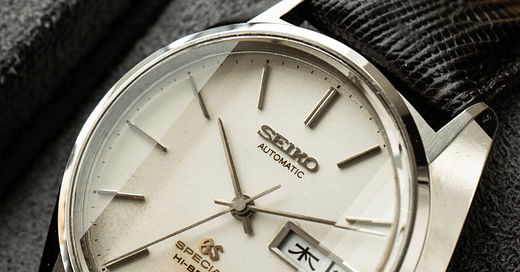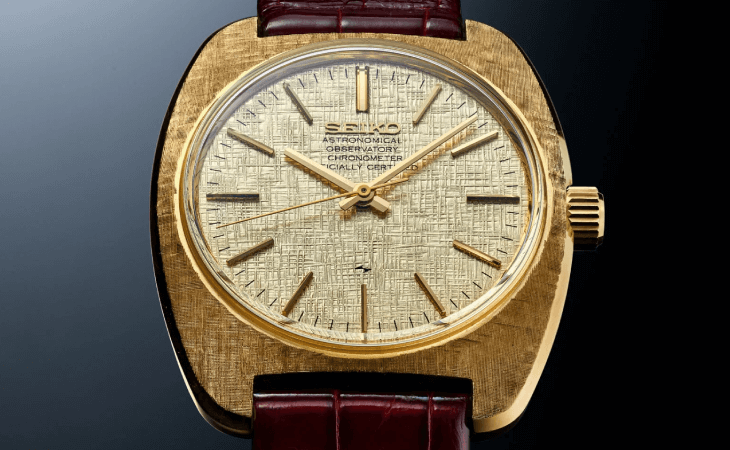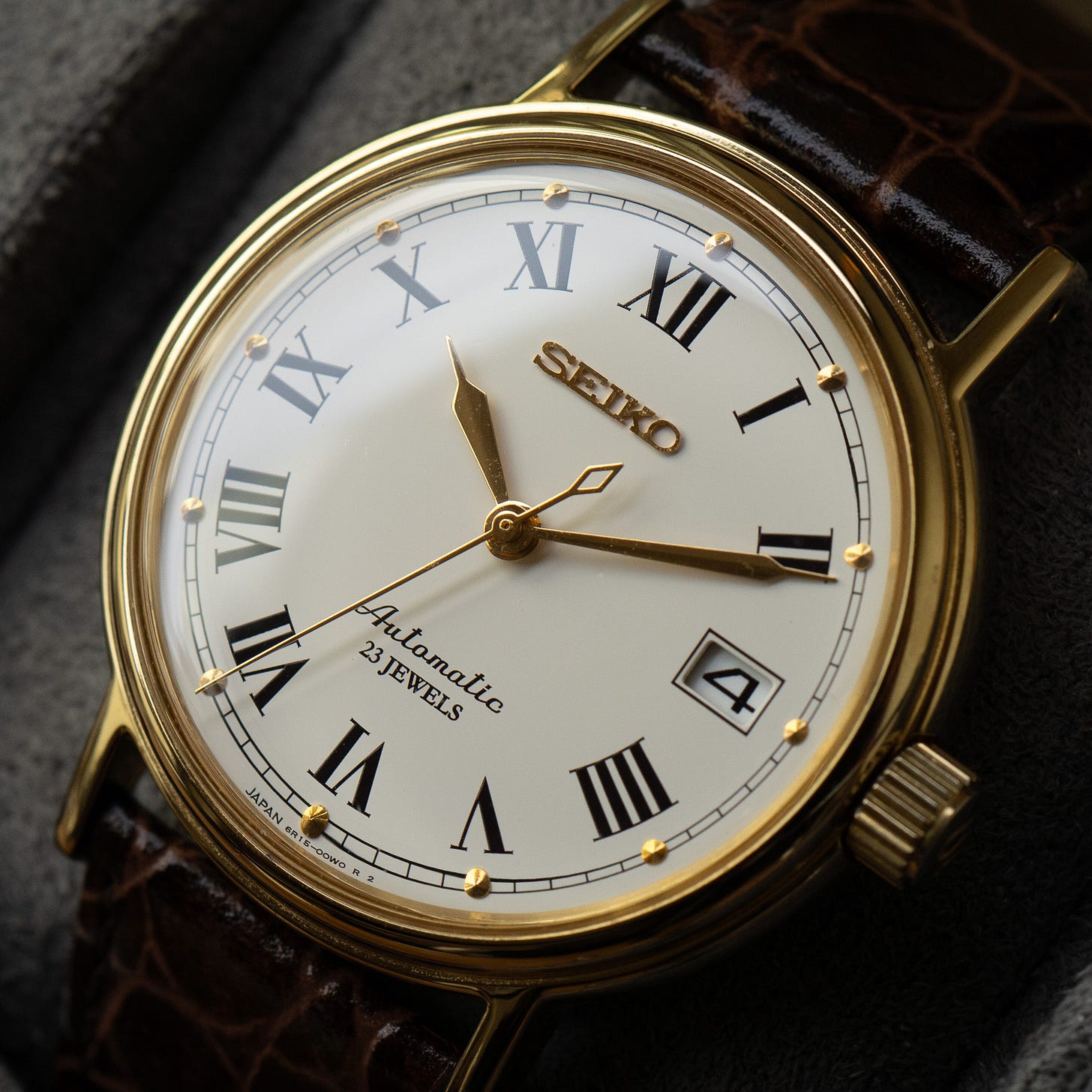How Seiko Beat the Swiss at Their Own Game
And fallout that changed movement certification forever
The Precursor
It’s been a while since I put a custom-made watch together, so I’m excited to share my latest build today. But before we get into that, I’d like to explore the history of the rivalry between Swiss and Japanese watchmakers.
Grand Seiko 6156-8010 Double Faceted
Beating the Swiss at their own game. In 1973, the Swiss introduced a new benchmark for watch testing - the Contrôle Officiel Suisse des Chronomètres (COSC). This rigorous test awarded the coveted title of "Chronometer" to watches capable of maintaining an accuracy of -4/+6 seconds per day, over 15 days, in five positions and varying temperatures. Naturally, you might wonder: did Seiko dare to submit their watches for this prestigious certification?
No.
But Seiko wasn’t scared… it was angry.
Some of you might have realised that 1973 sounds very late for the Swiss to start officially testing movements, and you’d be right. Before COSC, the gold standard was Observatory Chronometer certification, established in 1766. You might even recognise some of their more famous graduates, like the Omega Constellation, whose “subtle” nod to the Observatory may be hard to spot:
I won’t bore you with the 200 years of Observatory history, but in order to explain why Seiko shunned the COSC standards in 1973, we need to focus on the death of the Observatory Chronometer standard in the late 1960s.
Prior to the 1964 Olympics, Seiko had almost no international presence, but thanks to their glorious horological display at the Tokyo Games, Seiko gained the confidence to venture out of Japan. And in 1968, Seiko arrived at the Geneva Observatory trials and Neuchâtel Observatory trials with suitcases full of the 45 Series movements ready for certification. From my mildly conceited tone you can probably tell things went well.
Geneva’s Observatory ran the timekeeping competition that year, and Seiko’s 45 Calibre took the seven top spots for mechanical accuracy. Whereas Neuchâtel’s Observatory was only offering Chronometer Certification, and of the 103 individual 45 Calibres submitted by Seiko, 73 exceeded the Chronometer requirements. This was, as far as I can tell, the largest number of movements to have ever received individual chronometer certification in a single year.
Unlike Swiss competitors who often submitted "representative" movements - custom-tuned for competition and not practical examples of production watches - Seiko decided to certify each of their movements individually. These Chronometer certified movements would go on to be placed inside the first 73 examples of the 4520-8020 Seiko Astronomical Observatory Chronometer. If you manage to find one of these solid gold watches today, it will set you back at least $45,000, but I’ve seen them go for as much as $90,000:
But Seiko’s success didn’t stop with mechanical movements. They also brought three quartz calibres, which swept the first, second, and third positions. With no category distinctions between quartz and mechanical movements, Seiko dominated the top 10 outright.
Now, imagine you’re the Geneva Observatory. On your home soil, inside an observatory that’s been certifying Swiss Chronometer-grade movements for over 200 years, an upstart Japanese watchmaker has just cleanly swept the top 10 of a competition that’s never been won by a foreign watchmaker. How do you react?
You cancel the entire Observation Chromometer standard, of course. The standard would re-emerge in 1973 as COSC, but with a notable caveat:
Only Swiss-made movements are eligible for testing.
That feels oddly targeted, doesn’t it? There are various loopholes a non-Swiss watchmaker can exploit to have their movement classed as “Swiss-made”, but Seiko wasn’t interested in cowing to this obvious affront, and would instead create their own testing environment.
So before the COSC standard could even be established in 1973, Japan had bettered it with their own Grand Seiko Standard in 1971. The more rigorous test would go on to produce the VFA and 6156 Special, showcased today, which were certified to a daily accuracy of +/- 2 seconds per day and +/- 3 seconds per day, respectively, compared to the COSC standard of -4/+6 seconds per day.
Even now, the COSC standard is, in my opinion, below the Grand Seiko equivalent. “Representative” movements are still accepted by COSC, whereas Grand Seiko individually tests every single movement. The 9S on your wrist isn’t just part of a theoretical certification - it has been tested and verified itself.
The 6156-8010 on offer today embodies this spirit of excellence. This rare Hardened Stainless Steel (HSS) variant features two vertical facets on its sapphire crystal, a bi-lingual quick-set day/date complication, and the iconic 36,000 Hi-Beat movement. The solid gold GS medallion on the caseback is another hallmark of vintage Grand Seiko watch.
The case demonstrates Taro Tanaka’s “Grammar of Design” philosophy, while its 36mm case width is the undisputed classic dress watch size. The dial has developed a speckled patina, a common sight on almost all Grand Seikos from this era, adding character to its authentic vintage appeal.
The 6156-8010 is now available to buy on our website.
Recently serviced, and running at +2 seconds per day, averaged across three positions. It’s in great condition overall. The sapphire crystal is immaculate, and the HSS case only has mild signs of wear. The edges and original brush marks are sharp. The medallion on the caseback is free from any signs of aging or damage. The strap is aftermarket.
Custom “EKG” Open Heart Watch
A reminder to make every second count. I threatened the readers of this newsletter with a new custom-made watch before the end of the year, and here it is! The “EKG”, named after the electrocardiogram heartbeat reading that’s acting as its second hand.
The average human heart beats up to three billions times before eventually giving up, and this custom watch has been designed to make you consider the importance of every beat. To further drive this point home, and represent its fragility, the dial that houses the 18k gold heart is paper-textured.
It’s undeniable satisfying to watch the heart “beat”. Thanks to the skeletonised NH71 Seiko movement, the exhibition caseback, and the very literal open heart dial design, you can see all the watch through the watch from the front.
The EKG’s specifications are as follows:
Chapter Ring: Black and gold, hand-painted, with Kanji hour markers (1-12)
Dial: Black paper-textured surface with an 18k gold heart centrepiece
Hands: Dauphine hour and minute hands paired with a custom-designed EKG heartbeat second hand
Crystal: Flat sapphire crystal with a clear anti-reflective coating on the underside
Case: Nautilus-style with a mix of brushed and mirror-polished surfaces, screw-down crown, and 50m water resistance
Movement: Regulated Seiko NH71 skeletonised movement, accurate to +/- 5 seconds per day with a 42-hour power reserve
Strap: Matte-black calf-grain leather with a gold buckle.
The EKG is now available to buy on our website.
In brand new, unworn condition. I’ve made six, and plan on officially listing them for sale next week, but I’ve added a couple to the website for any interested readers.
Seiko SBRS00F / 7S26-0620 ANA Pilot’s Watch
Limited availability, not limited edition. Like Studio Underd0g’s Pizza watches I mentioned last week, the All Nippon Airways (ANA) Seiko wasn’t technically a limited edition watch, but it wasn’t widely available either. To purchase one, you had to be aboard a domestic ANA flight in Japan, hope the plane had stock on board, and, crucially, know the watch even existed. It was absent from Seiko’s catalogues, appearing only in ANA’s in-flight catalogues. And what sort of monster actually reads those?
Produced in 2003 and discontinued nearly 20 years ago, this elusive timepiece was, according to the stamped caseback, designed by ANA’s pilots. It boasts a high-visibility layout that remains very legible in all lighting conditions, ensuring it meets the practical demands of the cockpit.
The 7S26 ANA Pilot’s Watch is now available to buy on our website.
Perfect, unworn condition, with the original strap.
Seiko 7D46-0AE0 “Big Date” Kinetic Perpetual
One of the very few "Big Dates” offered by Seiko. Perhaps it’s because they remind me of the old airport split-flap displays, but there are few watch complications I enjoy fiddling with more than a Seiko Big Date. The gears flick through the dual date wheels at lightning speed, allowing you to fast forward entire months with a flick of your fingers.
Sadly, but conveniently, this is a Perpetual Calendar powered by a Kinetic movement meaning it rarely needs adjustment. Not only does it effortlessly handle months of varying lengths (even leap years), but it also features a power conservation mode. After 24 hours of inactivity, the watch goes to sleep, storing the correct time and date for up to four years. Simply pick it up, give it a quick shake, and watch as the six hands spin into place with remarkable precision.
The lightweight case and bracelet are made of solid titanium, ensuring exceptional comfort for everyday wear.
The Big Date is now available to buy on our website.
In good condition. The bezel and case have a few marks on it, but the rest of the watch is in good shape. The crystal, dials and hands are all immaculate.
Seiko SARB044
It definitely doesn’t look like a Seiko. Released in 2008 and discontinued after two years, this Seiko isn’t commonly seen outside of Japan, which is a shame as its design feels perfectly suited to life in Europe. The elegant Roman numerals and raised crystal exude a distinctly Swiss aesthetic, while its 37mm diameter aligns beautifully with modern dress watch proportions.
But let’s pause for a moment to talk about the Roman numeral for 4 on watch dials. Some might be tempted to point out that Seiko got it “wrong" by using IIII instead of IV. However, this isn’t a mistake - it’s a longstanding tradition known as the Watchmaker’s Four.
Why IIII, then? Although various theories exist, the most compelling explanation is visual symmetry.
Consider the layout of the numerals in the diagram above:
Three I, Four X, and Five V numerals, or Four X, I and V numerals? The balance provided by the latter is a no-brainer, and thus, the Watchmaker’s Four was born!
The SARB044 is now available to buy on our website.
In great condition. No box or papers.
Seiko SBCJ023 “SSASS” Alpinist
The SSASS (Seven Summits Actions for Sustainable Society) is the rarest of the modern Alpinist watches. Limited to just 500 pieces, the SBCJ023 has become a true grail for Seiko collectors. I covered its fascinating history in detail a few weeks ago - if you missed that write-up, you can click here to read it in full.
Its unique backstory and exceptional design make it a standout in Seiko’s storied line-up.
The SBCJ023 is now available to buy on our website.
In great condition. Comes with the box and guarantee. No significant markings anywhere.
Don’t forget to follow my Instagram to see all of the watches above in full cinematic glory later this week.















